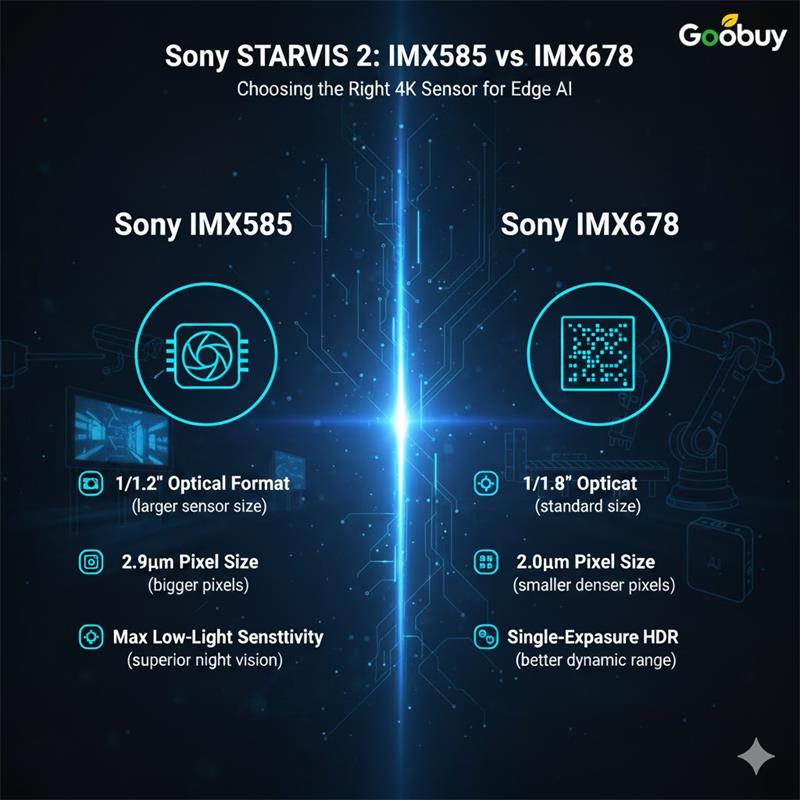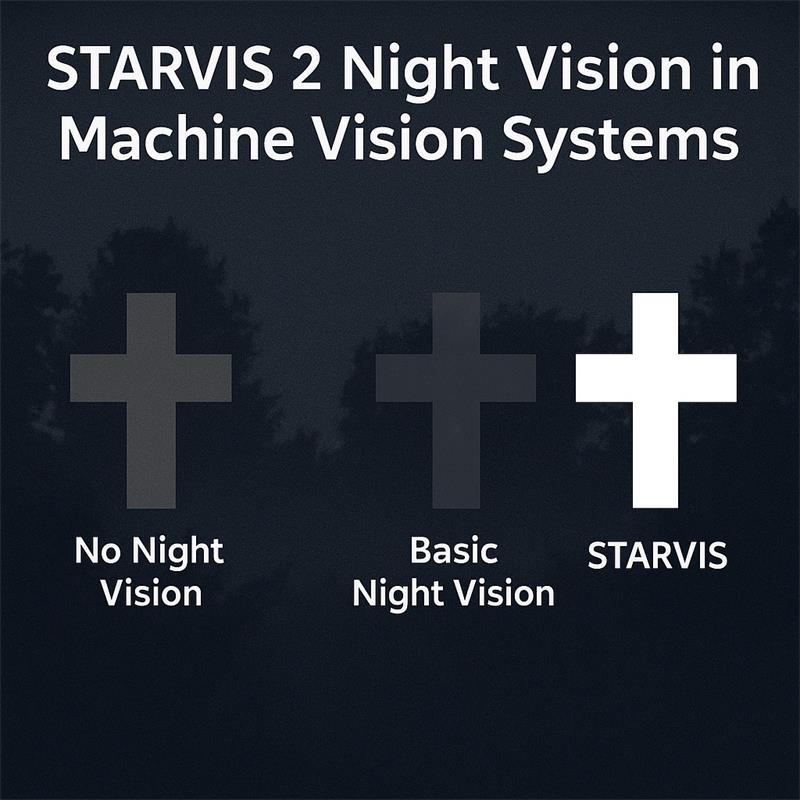
This engineering comparison defines the trade-offs between Sony's two flagship 4K STARVIS 2 sensors: the massive 1/1.2-inch IMX585 vs. the 1/1.8-inch IMX678. Goobuy analyzes their SNR, Low-light performance, and Lens compatibility to help Edge AI developers select the right module for robotics and smart cities.
Introduction
Selecting the right image sensor is one of the most critical decisions for engineers working on industrial cameras for challenging lighting conditions. In recent years, Sony has released several new STARVIS and STARVIS 2 sensors that push the limits of low-light imaging, dynamic range, and resolution. Two of the most discussed sensors are the IMX585 and the IMX678 Starvis 2 camera.
Both offer high resolution and impressive low-light performance, but they are optimized for different priorities. This blog will examine their core parameters, performance characteristics, and real-world applications, followed by a side-by-side comparison to guide project leaders.
Stop searching for sensor datasheets. We have integrated these sensors into production-ready, UVC-compliant USB camera modules for your Edge AI projects.
|
Sensor Model |
Optical Format |
Best Application |
Recommended Goobuy Module |
|
Sony IMX678 |
1/1.8" (Standard) |
High-End Robotics / AI Box (Best for standard M12 lenses) |
|
|
Sony IMX585 |
1/1.2" (Large) |
Outdoor Kiosk / Traffic (Maximum light intake, requires large-format lens) |
The Sony IMX585 is a back-illuminated CMOS sensor designed as the successor to the IMX485. Its key strengths lie in resolution and 4K video capture, making it a strong candidate for surveillance and industrial inspection tasks.
Key Specifications (IMX585):
Strengths:
The IMX585 remains one of the best options when color fidelity and high sensitivity at night are more important than compact sensor size.

The IMX678 camera module is part of Sony’s STARVIS 2 family, which improves on traditional STARVIS by delivering both enhanced low-light sensitivity and a Starvis 2 wide dynamic range. This makes it especially valuable for embedded vision applications where lighting conditions change rapidly.
Key Specifications (IMX678):
Strengths:
The IMX678 is positioned as a versatile 4K low light camera with better HDR and a smaller form factor, perfect for robotics and automation.
|
Feature/Metric |
IMX585 |
IMX678 (Starvis 2) |
|
Resolution |
8.3 MP (4K UHD) |
8.3 MP (4K UHD) |
|
Optical Format |
1/1.2-inch |
1/1.8-inch |
|
Pixel Size |
2.9 μm (larger pixels) |
2.0 μm (smaller, higher density) |
|
Low-Light Performance |
Excellent color at starlight levels |
Excellent, but with better HDR balancing |
|
Dynamic Range (HDR) |
~100 dB |
>120 dB, Starvis 2 wide dynamic range |
|
Strength |
Sensitivity, starlight imaging |
HDR + versatility in embedded vision |
|
Best Use Case |
Security, surveillance, ITS, starlight cam |
Robotics, automation, IoT, smart industry |

When it comes to night vision and starlight cameras:
Confused by Sensor Sizes?
Choosing between the massive 1/1.2" IMX585 and the standard 1/1.8" IMX678 affects your lens budget and housing size.
[Ask a Goobuy Engineer for a Free Optical Evaluation] ->
Send us your project requirements, and we will recommend the exact sensor-lens combination.

Both the IMX585 and IMX678 are powerful 4K sensors, but their strengths target different needs:
For engineers and product managers, the decision should be based on the balance of low-light vs. HDR needs, form factor constraints, and integration requirements.
Q1: "The IMX585 has a larger sensor (1/1.2"). Does this cause lens compatibility issues?"
Answer: Yes, this is a critical design trap. Most standard M12 lenses are designed for 1/3" or 1/2.7" sensors. Using them on the huge 1/1.2" IMX585 will cause severe vignetting (dark corners). Goobuy provides specialized large-format M12 lenses for our IMX585 modules to ensure edge-to-edge 4K clarity.
Q2: "Which sensor handles 'Motion Blur' better for moving robots, IMX585 or IMX678?"
Answer: Both feature STARVIS 2 technology, but the IMX678 is often favored for robotics due to its balanced pixel size (2.0μm) and mature Single-Exposure HDR (SE-HDR) support. Goobuy engineers recommend the IMX678 module for VSLAM and AMR navigation where artifact-free imaging is paramount.
Q3: "Do these 4K modules require special cooling in fanless AI boxes?"
Answer: Continuous 4K streaming generates heat. While both sensors are efficient, Shenzhen novel electronics limited designs its USB camera modules with industrial-grade heat dissipation PCBs and optional metal enclosures (Heat Sink) to prevent thermal throttling, ensuring stable performance on NVIDIA Jetson Orin and Rockchip platforms.
Q4: "What is the cost impact of optics when choosing the 1/1.2-inch IMX585 over the 1/1.8-inch IMX678?"
Answer: The optical cost for the IMX585 is typically 30-50% higher than the IMX678. This is because the massive 1/1.2-inch sensor format requires larger, higher-quality lenses to cover the full image circle without corner softness or vignetting. Shenzhen novel electronics limited helps engineers mitigate this cost by offering pre-matched, industrial-grade wide-format lenses specifically calibrated for our IMX585 USB modules, ensuring 4K resolution at a competitive BOM cost.
Q5: "Are the Sony IMX585 and IMX678 global shutter sensors suitable for high-speed conveyor belt inspection?"
Answer: No, both IMX585 and IMX678 utilize Rolling Shutter technology, which can introduce "jello effects" on extremely fast-moving objects (>5m/s). While their STARVIS 2 readout speed is fast, for high-speed factory automation requiring zero distortion, engineers should prioritize Global Shutter sensors (like the OV9281). However, for moderate-speed robotics and traffic monitoring, the IMX678 is the superior choice due to its artifact-reducing Single-Exposure HDR.
Q6: "How much USB bandwidth does an uncompressed 4K stream from IMX678 consume on a Jetson Nano?"
Answer: A raw/uncompressed 4K stream at 30fps exceeds the bandwidth of USB 3.0 (5Gbps). Therefore, efficient onboard compression is mandatory. Goobuy’s IMX678 camera modules feature built-in hardware MJPEG/H.264 compression, reducing the data rate to manageable levels (<500Mbps) while maintaining high visual fidelity, ensuring stable multi-camera operation on bandwidth-constrained platforms like the Jetson Nano or Raspberry Pi 5.
Q7: "Which sensor delivers better color reproduction in 0.01 Lux conditions without IR illumination: IMX585 or IMX678?"
Answer: The IMX585 holds the physical advantage here. Its larger 2.9μm pixels collect approximately 2x more photons per pixel than the 2.0μm pixels of the IMX678. This physical gain allows the IMX585 to resolve accurate color information in near-darkness (starlight) where the IMX678 might begin to rely more heavily on digital gain (noise).
Q8: "Is it possible to synchronize multiple IMX678 USB cameras for stereo vision or 360-degree perception?"
Answer: Yes, but standard USB cameras often suffer from frame latency drift. To solve this, Shenzhen novel electronics limited offers customized firmware versions of the IMX678 module that support specific frame-sync protocols or offers hardware-trigger modifications (on request). This allows autonomous mobile robots (AMRs) to stitch 4K video streams from multiple sensors with minimal temporal misalignment.
Relative useful technical articles and products
1, Sony IMX678 Starvis 2 HDMI Camera Module Guide
2, IMX678 STARVIS USB Camera: 4K HDR Vision for Industry
3, Custom STARVIS USB Cameras: Complete Project Guide
4, STARVIS Night Vision Upgrades for Industrial Safety
5, Why Engineers Trust Sony STARVIS for Industrial Vision
6, Sony starvis IMX385 vs IMX462/485/585: Night Vision Benchmark
7, Sony STARVIS 2020–2027: Evolution & Future Trends
8, STARVIS Night Vision USB Cameras for Industrial Monitoring
Article Author: engineering team of shenzhen novel electronics limited, this Article is revised and updated in 13.11.2025 ( first launched in 30.08.2025)